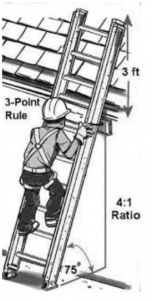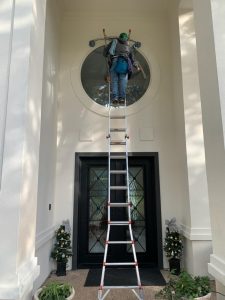Having been involved in window cleaning for so long, a lot of the work can become routine. Fill the bucket, assemble the tools, cut the rubbers, tie off the ladders and you’re ready to go!
 I remember a day of gutter cleaning a few years back with one of my top technicians. We were moving along really efficiently, knowing exactly where the other would go when we pulled up to a house. One of the homes, our last, had a higher than normal front porch with gutters along the edges. I had a few sections of stack ladder (a very efficient ladder type to fit inside the vans) in my hands which I thought would be plenty. I stacked the ladder sections, put it to the ground and against the gutter line. The pitch of the ladder was clearly terrible; practically 90 degrees. I looked at my partner and said “I got this”.
I remember a day of gutter cleaning a few years back with one of my top technicians. We were moving along really efficiently, knowing exactly where the other would go when we pulled up to a house. One of the homes, our last, had a higher than normal front porch with gutters along the edges. I had a few sections of stack ladder (a very efficient ladder type to fit inside the vans) in my hands which I thought would be plenty. I stacked the ladder sections, put it to the ground and against the gutter line. The pitch of the ladder was clearly terrible; practically 90 degrees. I looked at my partner and said “I got this”.
My partner immediately said “nah, nah, c’mon man! Go grab another ladder.” He was right. What would take an extra two minutes of going to grab another ladder saved me in what would have been an entirely avoidable accident! Of course, I listened and we completed our work for that day. That was almost 10 years ago, before having the two kids that I have now.
Naturally, risk calculation changes when you have kids or have other people who depend on you. But the fact is clear: accidents can be not only costly for your health, but also real dollars in business.
So what can we learn from my anecdote?
 According to the Occupational Safety and Health Administration (OSHA), falls from ladders account for 20 percent of all fall-related injuries and deaths. Furthermore, most ladder deaths are from falls of 10 feet or less! The reason behind this is that workers generally proceed with more caution if they are operating a ladder at greater heights. Hence, why I was quick to use a poor ladder choice because the risk at a lower height did not appear to be so great.
According to the Occupational Safety and Health Administration (OSHA), falls from ladders account for 20 percent of all fall-related injuries and deaths. Furthermore, most ladder deaths are from falls of 10 feet or less! The reason behind this is that workers generally proceed with more caution if they are operating a ladder at greater heights. Hence, why I was quick to use a poor ladder choice because the risk at a lower height did not appear to be so great.
March was National Ladder Safety month, an annual event hosted by the American Ladder Institute (ALI), with the support of many major ladder and safety organizations. ALI reports that more than 300 people die from a ladder-related accident each year and there is a 1 in 127 chance of dying from a fall. These accidents are preventable. Here are some safety tips shared during last month’s campaign.
Proper ladder selection is one of the most important choices before you even step foot onto the ladder. Make sure that it cannot only reach what you need to access, but give enough clearance that you won’t need to stand above the highest rungs to reach it. Additionally, the ladder should be in good condition, with no cracks or defects that could compromise its stability.
The next step is to safely transport the ladder safely from the truck across the property between set ups. This can be done carrying “over the shoulder” or oftentimes cleaners may be holding the ladder vertically as they move from one window to the next. Always be aware of overhead tree branches and/or power lines. The potential of property damage when a ladder goes down is as great of a risk as the individual straining and injuring themselves to maintain balance. In some cases, it can be safer to simply let the ladder fall and potentially break than to strain your shoulder trying to keep it upright.
Once in place, you want to make sure that the ladder is set up properly. The ladder should be placed on a stable, level surface (or made level with the use of levelers). Additionally, the ladder should be set up at the correct angle, which is approximately 75 degrees from the ground. Use the 1:4 ratio as a guide.
When ascending and descending the ladder, it is important to use proper climbing techniques. The climber should face the ladder and use both hands to climb. Additionally, the climber should avoid standing on the top rung of the ladder, which can be unstable and increase the risk of falling.
For any window cleaning company, it is essential to prioritize ladder safety and make it a core part of the company culture. This includes providing incentives for safe behavior, recognizing and rewarding employees who adhere to ladder safety guidelines, and holding regular safety meetings to discuss best practices and address any concerns or questions.
Besides driving, statistics would say that using ladders is the most dangerous thing we do in our businesses. Using ladders incorrectly can result in serious injuries and fatalities, which can be devastating for individuals, families, and businesses. This can have significant financial and human consequences for our companies, including lost productivity, increased insurance premiums, and legal costs.
 The most important thing I learned from my story above is that if I expect others in my company to work safely with ladders, then I need to lead by example! And I hope you will do the same.
The most important thing I learned from my story above is that if I expect others in my company to work safely with ladders, then I need to lead by example! And I hope you will do the same.
We encourage you to take four FREE ladder safety courses from the American Ladder Institute on the Campus IWCA page at www.iwca.org. AWCM-07_WEB (1)
Author: Nathan Pierce, Owner at Fish Window Cleaning (Boston, MA), Chair of the IWCA Safety and Education Committee


Recent Comments